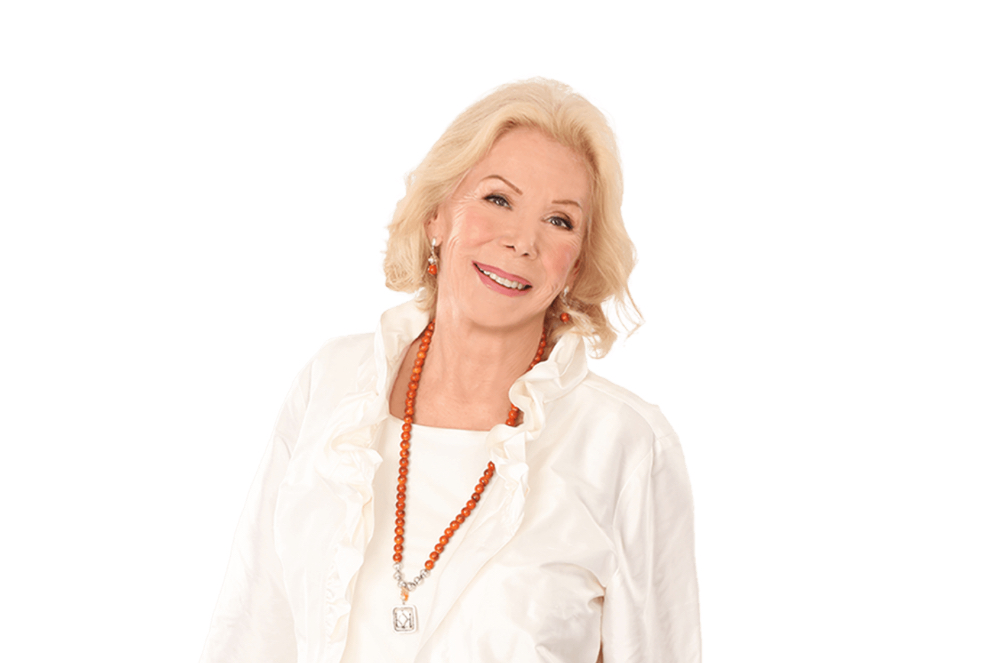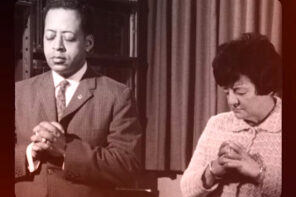The news of Louise Hay’s death took me right back to the mid-1980s and the worst of the AIDS crisis, when her books and tapes were everywhere in the homes and hospital rooms of the sick and dying. Out of respect for friends and lovers among those frightened young men, I never said what I thought then and still think now: i.e., what a load of cruel bullshit she peddles to people who deserve better.
AIDS made Louise Hay fabulously rich, in part because she was her own publisher and later the publisher of other “name it and claim it” types who likewise rose to wealth and fame thanks in part to the Hay touch. Wayne Dyer, Suze Orman, Tavis Smiley, Deepak Chopra, and Marianne Williamson: all of these were first published under the Hay House imprint.
In a perceptive 2008 profile for the New York Times Magazine, Mark Oppenheimer wrote that we all “live in Louise Hay’s world,” though we may not know it. For example, the practice of writing out and reciting a set of sunny “affirmations,” in the expectation that doing so will somehow transform your life, owes its ubiquity to Louise Hay. Without a Louise Hay—and I suppose without an Oprah Winfrey—there would be no Rhonda Byrne (The Secret—30 million copies and counting).
Hay had what every successful fraudster needs, which is the capacity to lie boldly and never turn back. Although no medical professional could ever be found to corroborate her story, she maintained all her life that she had cured her own cervical cancer, which she attributed to excess anger on account of childhood sexual abuse, by forgiving herself.
Based on this whopper, Hay went on to compile her famous list of ailments and their probable sources in wrong attitudes so that others could likewise triumph over their mortal foes. If you have Alzheimer’s, that’s probably because you refuse to “accept life as it is.” If you have leprosy, it’s because of your “inability to handle life at all.” Anorectal bleeding? That must be your “anger and frustration” talking. Hay included this list in her 1984 breakout book, You Can Heal Your Life, which ultimately sold more than 35 million copies after her work with AIDS patients in LA—including the notorious Hayrides—won her celebrity via the Oprah and Donahue shows.
It’s not my purpose here to catalog the immense damage done by “think positive—you can do it” trumpery; Barbara Ehrenreich already did that job, and did it brilliantly, in 2009’s Bright-sided.
Instead, I want to place Louise Hay within the family tree of religious science. The many and varied ramifications of this peculiarly American religious movement make it look more like a forest than a tree, and because this forest has thrived in the suburbs of Christianity, its sheer scope and force is seldom fully recognized. But it really is one big tree. The branch that specifically gave us Louise Hays calls itself Religious Science. Other early branches include Unity Church and the Church of Divine Science. But there’s no question that the movement’s biggest branch by far is the one that grows unnoticed inside of what looks from the outside like garden variety Christianity. Think Joel Osteen and T.D. Jakes. These contemporary hucksters don’t claim that a change of attitude can heal broken bodies (does anyone besides me miss Oral Roberts?), but they most certainly do claim that positive thinking can do wonders for broken credit.
Slipping wishful thinking into Christian camouflage makes the medicine go down easier. I mean, when it’s 1920 and a dude named Paramahansa Yogananda shows up to something he’s calling the Self-Realization Fellowship, you know what you’re dealing with. Likewise, and thanks to hardcore racism, among white people a certain amount of sharp skepticism will likely greet the preachments of any pitchman who is black and named Father Divine, Daddy Grace, or Ceflo Dollar. But when the prophets and promoters have WASP-y names like Mary Baker Eddy or Ernest Holmes or Aimee Semple McPherson or Norman Vincent Peale—all of them well-versed (literally) in the tropes of traditional Christianity—the credulous hardly notice that what these folks are selling has drifted into the realm of magical thinking.
Holmes in particular claimed that his teachings, including “openness at the top,” were all nothing more than elaborations of the teachings of Christ. The International New Thought Alliance, founded in 1915, did not scrub multiple references to Christianity from its Declaration of Principles until 1957, when a new statement proclaimed the “inseparable oneness of God and Man.”
Let us then have a closer look at the one huge family tree, starting with the observations of the great William James, speaking here in his 1901-1902 Gifford Lectures about what he called “Mind-cure” spiritualism:
It is an optimistic scheme of life, with both a speculative and a practical side. In its gradual development during the last quarter of a century, it has taken up into itself a number of contributory elements, and it must now be reckoned with as a genuine religious power. It has reached the stage, for example, when the demand for its literature is great enough for insincere stuff, mechanically produced for the market, to be to a certain extent supplied by publishers – a phenomenon never observed, I imagine, until a religion has got well past its earliest insecure beginnings.
One of the doctrinal sources of Mind-cure is the four Gospels; another is Emersonianism or New England transcendentalism; another is Berkeleyan idealism; another is spiritism, with its messages of “law” and “progress” and “development”; another the optimistic popular science evolutionism of which I have recently spoken; and, finally, Hinduism has contributed a strain. But the most characteristic feature of the mind-cure movement is an inspiration much more direct. The leaders in this faith have had an intuitive belief in the all-saving power of healthy-minded attitudes as such, in the conquering efficacy of courage, hope, and trust, and a correlative contempt for doubt, fear, worry, and all nervously precautionary states of mind.
Note that Dr. James, in looking back over the last part of the 19th century, already sees the New Thought movement as a “mass imposing in amount.” Prescient though he was, and drawn to it though he was in his own life, had William James lived beyond 1910 he might still have been stunned to witness the spectacular growth of “healthy-minded” religiosity during the first half of the 20th century, with a huge new mass of it surfacing in California.
From its earliest days, many of New Thought’s leading teachers and practitioners
and promoters were women, which is not to say that women are more credulous but which is to say that women may well experience more suffering in an androcentric America.
What was first called New Thought in William James’s time came to be known as New Age thinking toward the end of the 20th century (Mark Oppenheimer’s profile of Louise Hay was titled “The Queen of the New Age”) but the gist of the belief system has never changed from the “optimistic scheme of life” that William James espied from his lectern in Edinburgh long ago. It’s a mashup of hooey about positive thinking, the law of attraction, self-healing, life force, creative visualization, and personal power.
But by now you may be asking, Why all the judgment? Why all the sarcasm? If millions and millions of people say that positive thinking helps them, who are you to complain?
My answer is that religious science (my preferred term for all of this) is unspeakably cruel to people who do everything the creed asks them to do—the affirmations, the visualizations, all of it—and nevertheless stay sick or stay broke or stay addicted or what have you. My answer is that positive thinking amounts to a terrible, if understandable, response to the problem of theodicy—the challenge of reconciling belief in a compassionate God with the intractable realities of suffering and evil.
Not that conventional Christianity does a whole lot better on the theodicy front. But conventional Christianity at least posits a sharp separation between us and God, meaning that God hasn’t necessarily failed when we fail to fix our problems through positive thinking. What’s more, the best Christian thought places God’s love above God’s power, abandoning traditional ideas of divine omnipotence and thus allowing us to conceive of God suffering with us. This to my mind is vastly better than the idea of God sitting up there on a big throne and answering some prayers and not others or (worse) “answering” some people’s prayers with the message that their suffering is actually good for them, that misery has a helpful “soul making” function. Ugh.
Unfortunately, most American Christians aren’t ready to give up the omnipotence idea. Many still expect God to function as a “cosmic bellhop,” as Harry Fosdick once put it in a vivid image. They will be disappointed. Some will turn to religious science and expect the God within to make things come out right. They will be disappointed.
There’s a big difference between believing that God dwells within us and believing that we are God.
By eliding the difference, people like Louise Hay grow rich and famous. Let it never be said that religious science doesn’t work: it clearly works for them. But for the rest of us? Maybe we just need to adjust our attitudes.





